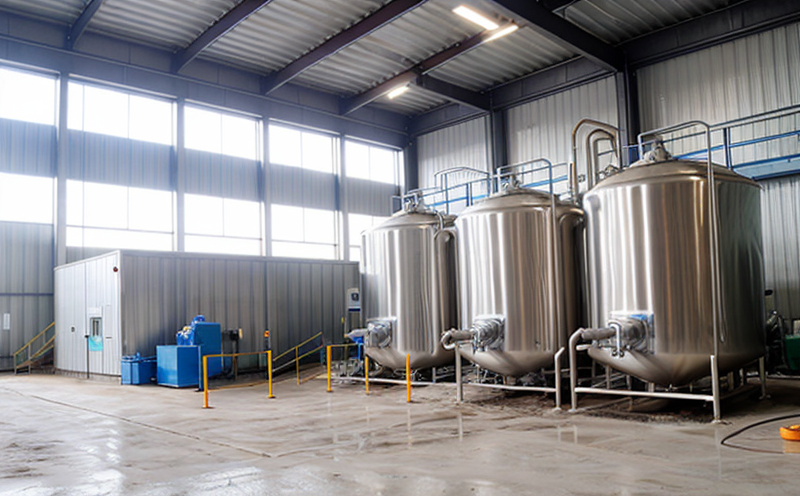ISO 15705 Chemical Oxygen Demand COD Test in Industrial Water
The ISO 15705 standard provides a robust methodology for the determination of chemical oxygen demand (COD) in industrial water. This test is crucial for monitoring and controlling the oxidation potential within industrial processes, particularly those involving wastewater treatment, as it indicates the presence of organic compounds that can be oxidized by potassium dichromate.
The ISO 15705 COD test is widely used across various industries including chemical manufacturing, petrochemicals, pharmaceuticals, and food processing. It helps in ensuring compliance with environmental regulations and internal quality control standards. By measuring the amount of oxygen required to break down organic matter in a given volume of water sample, this test provides insights into the efficiency of wastewater treatment systems.
The process involves several steps: sampling, dilution (if necessary), addition of reagents, heating, and titration. The accuracy of results depends heavily on proper sample handling and adherence to standardized procedures outlined in ISO 15705. Laboratories certified under this standard ensure precision by employing experienced personnel and state-of-the-art equipment.
Understanding the significance of COD testing requires knowledge about how it impacts different sectors:
- Clean Water Supply: Ensures that water sources used for potable purposes meet drinking water standards set forth by regulatory bodies like WHO or EPA.
- Sewage Treatment Plants: Helps monitor the effectiveness of treatment processes before releasing treated effluents into natural water bodies.
- Industrial Processes: Allows manufacturers to maintain optimal conditions for their operations while minimizing environmental impact.
The following table illustrates typical COD values found in various types of industrial wastewater:
| Type of Wastewater | Typical COD Range (mg/L) |
|---|---|
| Chemical Manufacturing | 20 - 150 mg/L |
| Petrochemicals | 30 - 400 mg/L |
| Pharmaceuticals | 50 - 600 mg/L |
| Food Processing | 100 - 800 mg/L |
To prepare a sample for testing, follow these steps:
- Collect representative samples from the source being tested.
- Transfer samples to appropriately labeled containers and seal them tightly.
- If transporting over long distances or extended periods, cool the samples immediately upon collection.
The testing procedure itself follows these key steps:
- Add measured quantities of potassium dichromate solution to each sample container.
- Heat the mixture according to specified parameters until complete oxidation occurs.
- Titrate any remaining oxidant using standardized sodium thiosulfate solution.
The results provide valuable information regarding overall water quality and compliance with regulatory limits. Regular monitoring allows for proactive adjustments in processes, thereby reducing operational costs and environmental risks associated with improper disposal of industrial waste.
Why It Matters
The importance of the ISO 15705 COD test cannot be overstated, especially within industries where water consumption is significant. Properly conducted tests not only help comply with international standards but also contribute significantly to sustainable practices. Here’s why:
- Environmental Protection: Reduces pollution by ensuring that treated effluents meet stringent discharge limits.
- Economic Efficiency: Enables businesses to operate more efficiently by identifying inefficiencies early on and making necessary corrections.
- Safety Assurance: Protects human health by preventing contamination of water resources with harmful substances present in industrial effluents.
- Regulatory Compliance: Helps avoid penalties and fines resulting from non-compliance with environmental laws.
By incorporating regular COD testing into routine maintenance schedules, organizations demonstrate their commitment to responsible stewardship. This proactive approach fosters trust among stakeholders including customers, regulatory authorities, and the broader community.
Quality and Reliability Assurance
The reliability of COD test results is paramount for ensuring accurate assessment of water quality. To achieve consistent and dependable outcomes:
- Standard Operating Procedures (SOPs): Adherence to documented protocols minimizes variability between tests conducted by different operators.
- Diligent Calibration: Regular calibration of instruments ensures accurate measurements throughout the measurement period.
- Control Samples: Utilization of reference materials allows for validation of test methods and equipment performance.
A well-structured quality management system enhances confidence in reported values. This includes implementing robust audit trails, maintaining detailed records of all analytical activities, and establishing clear lines of responsibility among personnel involved at every stage from sampling to reporting.
| Quality Assurance Metrics | Description |
|---|---|
| Data Accuracy | Ensures that reported COD concentrations align closely with actual values within acceptable tolerances. |
| Method Validation | Confirms that the chosen analytical method consistently yields reproducible results across multiple trials and diverse sample types. |
| Interlaboratory Comparisons | Promotes consistency among laboratories by comparing their findings using common test samples. |
Incorporating these practices into daily operations helps maintain high standards of performance and integrity in all aspects of COD testing.
Use Cases and Application Examples
The ISO 15705 COD test plays a pivotal role in several applications:
- Water Treatment Plants: Monitoring incoming raw water quality to adjust treatment strategies effectively.
- Industrial Facilities: Evaluating the efficiency of internal wastewater treatment systems before discharge into external environments.
- Research Institutions: Investigating pollutant sources and developing solutions for cleaner processes.
The table below provides examples of industries where ISO 15705 COD testing is essential:
| Industry Segment | Purpose |
|---|---|
| Chemical Manufacturing | Detecting contamination during production runs and assessing effectiveness post-treatment. |
| Petrochemicals | Monitoring oil spill cleanup efforts to ensure complete removal of hydrocarbons from water bodies. |
| Pharmaceutical Manufacturing | Verifying the absence of toxic residues in final products and ensuring compliance during manufacturing stages. |
| Food Processing | Tracking contamination levels throughout production lines to protect product integrity and public health. |
Case studies have shown that consistent application of ISO 15705 COD testing leads to significant reductions in operational costs due to minimized waste generation and optimized resource utilization. Additionally, it enhances reputation among consumers who increasingly demand eco-friendly products and services.





